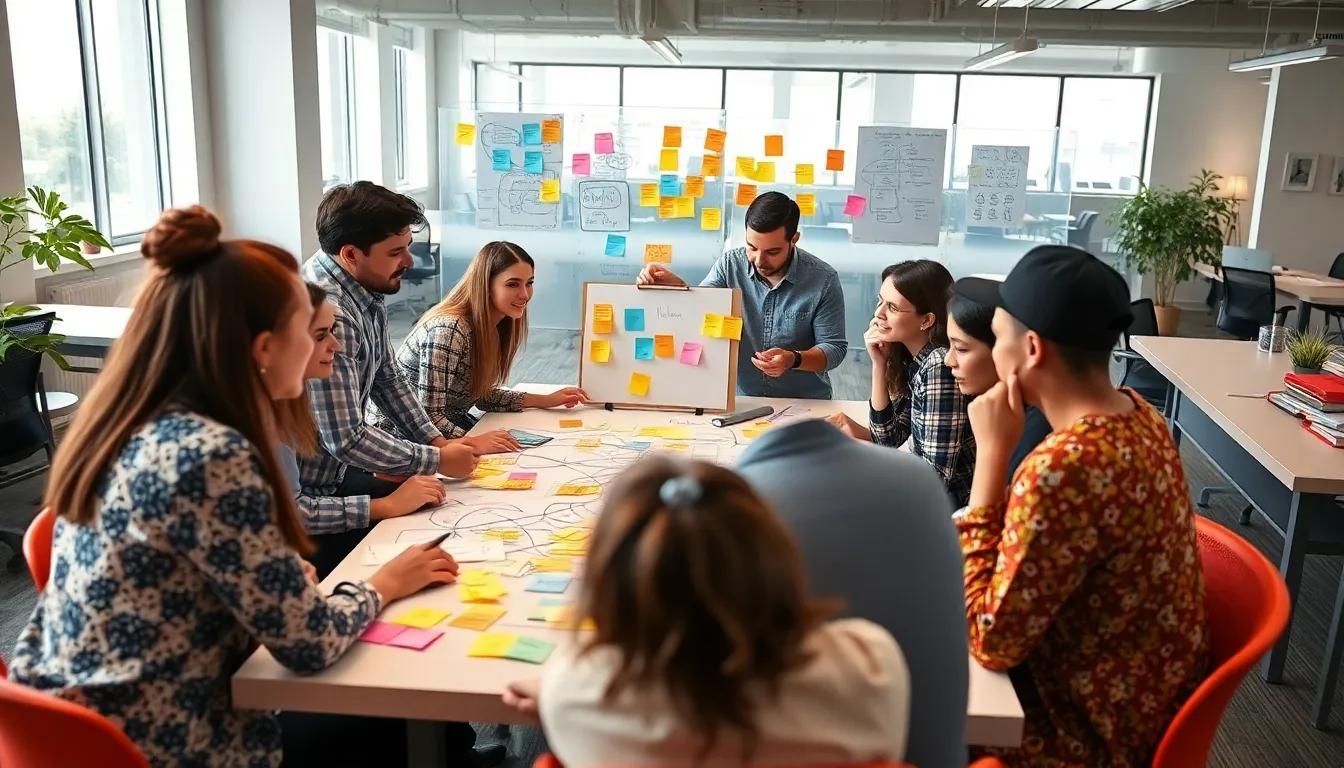Divergent thinking is a powerful cognitive process that fuels creativity and innovation. Unlike traditional linear thinking, which seeks a single correct answer, divergent thinking encourages exploration of multiple possibilities and solutions. It’s about thinking outside the box and embracing the unexpected, making it essential in fields ranging from art and design to science and business.
In today’s fast-paced world, the ability to generate unique ideas and approaches is more valuable than ever. Organizations and individuals alike are realizing that fostering divergent thinking can lead to breakthroughs and competitive advantages. By understanding and cultivating this skill, one can unlock new potential, enhance problem-solving abilities, and drive meaningful change.
Table of Contents
ToggleWhat Is Divergent Thinking?
Divergent thinking represents a key cognitive process that fosters creativity. It encourages the generation of multiple, varied ideas rather than converging on a single solution.
Definition and Explanation
Divergent thinking involves a brainstorming approach that emphasizes open-ended problem-solving. It allows individuals to explore diverse possibilities and connections. This process stimulates idea generation, critical for innovation. Techniques such as mind mapping and free writing help facilitate divergent thinking by enabling individuals to expand their thought processes beyond conventional boundaries.
Historical Background
Divergent thinking emerged as a significant concept in the mid-20th century. Psychologist J.P. Guilford introduced it in 1950 as part of his work on intelligence. His research distinguished between divergent and convergent thinking, asserting that both are vital to the creative process. Subsequent studies reinforced the importance of divergent thinking in various fields, from arts to sciences, highlighting its crucial role in enhancing creativity and problem-solving abilities.
Importance of Divergent Thinking

Divergent thinking plays a crucial role in fostering innovation and creative solutions across various disciplines. This cognitive skill not only enhances creativity but also provides significant advantages in problem-solving scenarios.
Role in Creativity
Divergent thinking encourages individuals to generate an array of ideas and solutions. It promotes creativity by breaking free from traditional thought patterns. For instance, brainstorming sessions often leverage divergent thinking to produce diverse outcomes. Techniques such as mind mapping allow for visual exploration of concepts, facilitating connections between seemingly unrelated ideas. Encouraging this approach leads to unexpected insights and innovative solutions, vital in fields like design and technology.
Applications in Problem Solving
In problem-solving contexts, divergent thinking proves invaluable. It allows teams to consider multiple perspectives and options when addressing complex challenges. For example, employing brainstorming methods often results in a wide range of possibilities, which can then be evaluated using convergent thinking to identify the best solutions. This blended approach proves effective in various settings, from business strategy development to scientific research. Organizations that prioritize divergent thinking cultivate an adaptable mindset, essential for navigating uncertainty and fostering resilience.
Techniques to Foster Divergent Thinking
Divergent thinking can be enhanced through various techniques that encourage creativity and idea generation. Below are key methods used to nurture this cognitive skill.
Brainstorming Methods
Brainstorming serves as a foundational technique for fostering divergent thinking. This group activity encourages participants to generate a plethora of ideas without immediate judgment or evaluation. Techniques include:
- Round-Robin Brainstorming: Participants take turns sharing ideas in a circular format, ensuring equal contribution.
- Brainwriting: Individuals write down ideas anonymously and share them later, reducing inhibition.
- Rapid Ideation: A time-bound method that promotes the quantity of ideas over quality, pushing participants beyond their comfort zones.
- Reverse Brainstorming: Participants identify ways to prevent a desired outcome, often uncovering unexpected solutions.
These methods emphasize collaboration and open-minded discussion, resulting in innovative outcomes.
Mind Mapping
Mind mapping is a visual representation technique that organizes thoughts and ideas around a central theme. This method enhances understanding and connection between concepts. Steps to implement mind mapping include:
- Start with a Central Idea: Clearly define the main topic in the center of the map.
- Add Branches for Subtopics: Create branches for related ideas, facilitating an expansive view of the topic.
- Incorporate Colors and Images: Use colors and visuals to stimulate creativity and enhance memory.
- Establish Connections: Draw lines to connect related branches, illustrating relationships between concepts.
Mind mapping promotes a holistic approach to idea generation, allowing for greater exploration of possibilities and innovative solutions.
Challenges in Practicing Divergent Thinking
Practicing divergent thinking presents several challenges that individuals may face. Addressing these barriers can lead to improved creative output and innovation.
Common Barriers
- Fear of Judgment: Individuals often hesitate to share ideas due to concerns about criticism from peers or superiors, stifling creativity.
- Limited Time: Busy schedules can restrict opportunities for brainstorming sessions, hindering the exploration of diverse ideas.
- Conformity Pressure: Group dynamics may encourage adherence to conventional thinking, discouraging unique contributions.
- Cognitive Bias: Preconceived notions can limit the ability to see beyond established patterns, restricting the generation of novel ideas.
- Inadequate Environment: Workspaces lacking creative stimuli or supportive atmospheres can detract from open idea generation.
Overcoming Obstacles
- Cultivating a Safe Environment: Establish a culture that encourages risk-taking and values all contributions, reducing fear of judgment.
- Scheduling Dedicated Time: Allocate specific time slots for brainstorming and creative exercises, ensuring consistent practice of divergent thinking.
- Encouraging Individuality: Promote unique perspectives by recognizing and celebrating diverse ideas within group settings.
- Challenging Assumptions: Regularly question existing beliefs and processes to prevent cognitive biases from hindering creativity.
- Enhancing Physical Space: Design workspaces that inspire creativity, incorporating elements such as color, art, and collaborative tools.
Divergent thinking stands as a crucial element in the pursuit of creativity and innovation. By embracing this approach, individuals and organizations can break free from conventional constraints and explore a multitude of ideas. This flexibility not only enhances problem-solving capabilities but also fosters an environment ripe for groundbreaking solutions.
The techniques discussed offer practical ways to cultivate divergent thinking, encouraging a culture of creativity. Overcoming the inherent challenges requires a commitment to creating supportive environments that value diverse perspectives. As the world continues to evolve, the ability to think divergently will remain essential for those seeking to drive progress and navigate complexities effectively.






